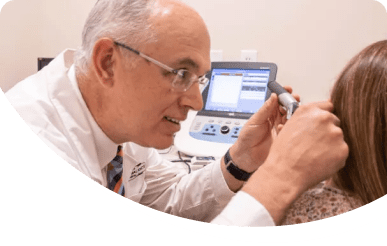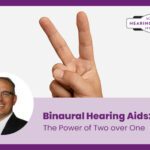Advanced Hearing and Balance Specialists have audiologists providing professional ear wax removal in Utah and South Nevada.
Ear wax, medically known as cerumen, is a natural substance produced by glands in the ear canal. It serves several important functions in maintaining ear health. It acts as a protective barrier, trapping dust, dirt, and other particles to prevent them from reaching deeper into the ear. Ear wax has antimicrobial properties, helping to fend off infections by inhibiting the growth of bacteria and fungi in the ear canal.
While ear wax is typically beneficial, it can sometimes accumulate excessively, leading to blockages or discomfort. Factors such as the shape of the ear canal, genetics, and personal hygiene habits can influence the rate of wax buildup. Symptoms of excessive ear wax may include earache, hearing loss, tinnitus/ringing in the ears, or a sensation of fullness in the ear.
In such cases, ear wax removal may be necessary to alleviate symptoms and restore normal hearing. However, it is crucial to exercise caution when attempting to remove ear wax, as improper techniques can lead to complications such as ear canal abrasions, perforation of the eardrum, or pushing wax deeper into the ear canal.
Utah and South Nevada audiologists at Advanced Hearing & Balance Specialists can perform ear wax removal procedures safely and effectively.
Understanding Ear Wax
Ear wax is a mixture of secretions from glands in the ear canal, along with dead skin cells, hair, and other debris. The composition of earwax varies from person to person, but it generally contains fatty acids, cholesterol, alcohol, and squalene.
There are two main types of ear wax: wet and dry. Wet ear wax tends to be yellow to brown and is dominant in populations of African and European descent. Dry ear wax, on the other hand, is grayish and flaky, and more common among East Asians and Native Americans. The type of ear wax is determined by genetics.
Ear wax serves several important functions in maintaining ear health. It acts as a protective barrier, trapping dust, dirt, and other particles to prevent them from reaching deeper into the ear canal. This helps to protect the delicate structures of the inner ear from damage and infection.
Additionally, ear wax has moisturizing properties, helping to keep the skin of the ear canal soft and supple. It acts as a self-cleaning mechanism, gradually migrating from the deeper parts of the ear canal toward the outer ear, carrying along with it any trapped debris.
How Do You Know If You Have Ear Wax?
Identifying the presence of ear wax or cerumen buildup in the ears can involve a variety of signs and symptoms. Individuals may experience a sensation of fullness or pressure in the affected ear accompanied by a gradual decrease in hearing ability. Some may notice a ringing or buzzing sound in the ear, known as tinnitus.
Additionally, ear pain or discomfort, itching, and a feeling of ear blockage are common indicators of excess ear wax accumulation. In more severe cases, ear wax impaction can cause dizziness or vertigo, coughing, or even a foul odor emanating from the ear.
Several factors can contribute to the excessive production or impaction of ear wax. These include:
Naturally Occurring Factors: Some individuals naturally produce more ear wax than others due to genetic predispositions. The consistency and type of ear wax can also influence the likelihood of impaction.
Inadequate Cleaning: Improper cleaning practices, such as using cotton swabs or other objects to remove ear wax, can push the wax deeper into the ear canal, leading to impaction.
Ear Canal Abnormalities: Structural abnormalities in the ear canal, such as a narrow or curved canal, may impede the natural expulsion of ear wax, increasing the risk of impaction.
Hearing Aid Use: Individuals who use hearing aids are more prone to ear wax buildup, as the devices can interfere with the natural migration of wax out of the ear canal.
Age: Older adults tend to produce drier ear wax, which is more likely to become impacted.
Ear wax impaction can lead to various complications if left untreated. These may include temporary hearing loss, ear infections, inflammation of the ear canal, also known as otitis externa, and in rare cases, damage to the eardrum or other structures of the ear.
It is essential to recognize the signs of ear wax impaction and seek appropriate treatment to prevent these complications and maintain ear health. If experiencing symptoms of ear wax impaction, it is advisable to consult a healthcare professional for evaluation and management.
How To Clean Your Ears
When it comes to cleaning your ears at home, it is important to prioritize safety and avoid methods that can potentially cause harm or push earwax deeper into the ear canal.
Here are some safe and effective techniques for at-home ear wax removal:
Over-the-Counter Ear Drops
These drops are designed to soften ear wax, making it easier to remove. They typically contain hydrogen peroxide, saline solution, or mineral oil. To use, lie on your side with the affected ear facing upward and instill the recommended number of drops. Gently massage the area around the ear to help the drops reach deep into the ear canal. After a few minutes, tilt your head to allow the excess liquid and softened wax to drain out.
Ear Irrigation with Warm Water
This method involves flushing the ear canal with warm water to dislodge and remove ear wax. You can use a bulb syringe or a specialized ear irrigation kit for this purpose. Fill the syringe or kit with lukewarm water and gently insert the tip into the ear canal. Tilt your head to the side with the affected ear facing upward and squeeze the bulb or syringe to irrigate the ear. Allow the water to drain out, along with the loosened ear wax.
Ear Wax Removal Kits
These kits typically include softening drops, an irrigation syringe, and sometimes ear wax removal tools such as loops or scoops. Follow the instructions provided with the kit carefully, and avoid inserting any tools deep into the ear canal to prevent injury.
Regardless of the method used, there are some important Dos and Don’ts to keep in mind:
- Do use only softening drops, warm water, or specially designed kits for earwax removal.
- Do follow the instructions provided with the products carefully.
- Do consult a healthcare professional if you experience pain, bleeding, or persistent symptoms.
- Don’t insert cotton swabs, fingers, or any sharp objects into the ear canal, as this can push wax deeper or cause injury.
- Don’t attempt ear irrigation if you have a perforated eardrum, a history of ear surgery, or ongoing ear problems without consulting a doctor.
By following these guidelines and using safe techniques, you can effectively clean your ears at home and reduce the risk of complications associated with ear wax buildup.
If you are unsure about the best method for your situation or if you experience any difficulties, it is always a good idea to seek advice from an audiologist.
Advanced Hearing and Balance Specialists provides professional ear wax removal in Hurricane, UT, Murray, UT, Panguitch, UT, and other key locations in Utah.
You can also enjoy our exceptional hearing care services from our audiologists in Mesquite, NV.
How Does an Audiologist Clean Ears?
The audiologists at Advanced Hearing & Balance Specialists are trained to perform ear wax removal when necessary.
Individuals with underlying ear conditions, such as a history of ear infections, a perforated eardrum, or previous ear surgeries, should consult a medical professional before attempting any form of ear wax removal.
Audiologists and other healthcare providers have several safe and effective techniques for removing impacted ear wax. These may include:
Ear Syringing
This method involves flushing the ear canal with warm water to dislodge and remove ear wax. It is typically performed using a specialized irrigation syringe or a water jet device. The procedure is conducted under controlled conditions to ensure safety and efficacy.
Microsuction
Microsuction involves using a gentle suction device, usually under the guidance of a microscope, to remove ear wax. It is particularly suitable for individuals with narrow or sensitive ear canals, as it allows for precise and controlled removal of wax without the risk of pushing it deeper into the ear.
Curettage
Curettage involves using a small, curved instrument called a curette to scoop out ear wax manually. This technique requires skill and precision to avoid injuring the delicate structures of the ear canal.
During professional ear wax removal, patients can expect a thorough evaluation of their ears to determine the extent of wax buildup and any associated symptoms. The chosen removal technique will depend on factors such as the individual’s ear anatomy, the consistency of the wax, and any underlying medical conditions. Patients should communicate any discomfort or concerns to their audiologist or healthcare provider during the procedure.
Audiologists have the expertise and tools necessary to address ear wax buildup and associated symptoms safely, minimizing the risk of complications.
Ear Irrigation
Ear irrigation, also known as ear syringing, is a common technique used by healthcare professionals to remove excess ear wax or cerumen buildup from the ear canal. It involves flushing the ear canal with a gentle stream of warm water to dislodge and remove the impacted wax. Ear irrigation is often performed in medical settings, such as doctor’s offices, audiology clinics, or ear, nose, and throat (ENT) specialist practices.
The process of ear irrigation typically follows these steps:
Preparation: The patient is positioned comfortably, usually seated upright or lying on their side with the affected ear facing upward. The healthcare provider may examine the ear using an otoscope to assess the extent of wax buildup and ensure there are no signs of infection or other complications.
Warm Water Preparation: The healthcare provider prepares warm water for irrigation. Water temperature is carefully regulated to ensure it is not too hot or too cold, as extreme temperatures can cause discomfort or injury to the ear canal.
Irrigation Device Setup: An irrigation device, such as a bulb syringe or specialized ear irrigation kit, is filled with warm water. The tip of the syringe or kit is positioned at the entrance of the ear canal, ensuring a secure but gentle seal.
Irrigation Procedure: The healthcare provider gently squeezes the bulb syringe or activates the irrigation device, directing a steady stream of warm water into the ear canal. The water flows around the ear wax, softening it and dislodging any debris or buildup.
Drainage and Inspection: As the water flushes out the ear canal, it carries along with it the loosened ear wax and debris. The patient may feel a sensation of fullness or mild discomfort as the water flows through the ear. The healthcare provider may use a lighted otoscope to inspect the ear canal and ensure that all excess wax has been removed.
Repeat if Necessary: In some cases, multiple rounds of irrigation may be needed to completely clear the ear canal of wax buildup. The procedure is repeated as necessary until the ear canal is clear and free of obstruction.
Ear irrigation is a safe and effective method for removing ear wax when performed by an audiologist or trained healthcare professional. It is important to follow proper techniques and precautions to minimize the risk of complications and ensure optimal ear health.
If you experience symptoms of earwax buildup or have concerns about your ear health, consult a healthcare provider for evaluation and appropriate management.
FAQs About Ear Wax Removal
How do you know if you need ear irrigation?
If you are experiencing symptoms such as hearing loss, a sensation of fullness or pressure in the ear, earache or discomfort, or tinnitus/ringing in the ears, you may need ear irrigation. These symptoms can indicate excessive ear wax buildup, which can obstruct the ear canal and cause various issues.
When over-the-counter remedies like ear drops do not provide relief, it is essential to consult a healthcare professional. They can examine your ears to determine if ear irrigation or other interventions are necessary to address the issue safely and effectively.
Ear irrigation is a common technique used to remove impacted earwax under controlled conditions, typically performed by a trained healthcare provider. If you’re experiencing any of these symptoms, do not hesitate to seek medical advice for proper evaluation and management of your ear health.
Can I use a WaterPik to clean my ears?
Using a WaterPik or similar devices to clean your ears is not recommended. These devices are designed for dental hygiene and may exert too much pressure, potentially causing injury to the delicate structures of the ear canal or pushing earwax deeper.
Inserting high-pressure water into the ear canal can lead to complications such as ear infections, perforated eardrums, or damage to the ear canal. It is best to avoid using WaterPiks or similar devices for ear cleaning and instead opt for safer methods such as over-the-counter ear drops or seeking professional earwax removal from a healthcare provider.
If you have concerns about ear wax buildup or ear hygiene, consult an audiologist for personalized advice and guidance.
How often should I get my ears professionally cleaned?
The frequency of professional ear cleaning varies from person to person and depends on individual factors such as ear wax production, personal hygiene habits, and any underlying ear conditions.
In general, most people do not need regular professional ear cleanings unless there is a significant buildup of ear wax causing symptoms such as hearing loss, ear fullness, or discomfort.
For some individuals, this may occur every few years, while others may require ear cleaning more frequently. It is essential to listen to your body and seek professional assistance if you experience symptoms of ear wax buildup or if you have concerns about your ear health.
Audiologists at Advanced Hearing & Balance Specialists can assess your ears and recommend appropriate interventions based on your specific needs and circumstances.
Is it safe to use hydrogen peroxide in your ear?
While hydrogen peroxide can help soften ear wax, its use in the ear should be approached with caution. Hydrogen peroxide can be diluted with equal parts water and applied as ear drops to aid in the removal of excess earwax.
However, it is important to avoid using hydrogen peroxide if you have a history of ear problems, perforated eardrums, or ongoing ear infections. If you experience any discomfort, pain, or unusual symptoms after using hydrogen peroxide in your ear, discontinue use and consult a healthcare professional.
They can guide safe and appropriate methods for managing ear wax buildup and address any concerns you may have regarding your ear health.
Why does ear wax vary in color and texture?
Ear wax varies in color and texture due to several factors. The variation is typically influenced by genetics, age, and environmental factors.
The color of ear wax can range from light yellow to dark brown, with some individuals having wax that appears almost orange. This color variation is normal and does not necessarily indicate any health concerns.
Texture-wise, ear wax can be soft and moist or dry and flaky. Factors such as the amount of oil produced by the glands in the ear canal and the rate of skin shedding can affect the texture of ear wax. Humidity levels and exposure to dust or dirt can also influence the appearance and texture of ear wax.
Advanced Hearing & Balance Specialists | Professional Ear Wax Removal in Utah and South Nevada
Do not let ear wax buildup affect your hearing and well-being. Advanced Hearing & Balance Specialists offers professional ear wax removal services in Utah and South Nevada.
Take the first step toward relief and schedule your professional ear wax removal with Advanced Hearing & Balance Specialists today.
We have clinics conveniently located across Utah and Nevada including St. George, Cedar City, Murray, Hurricane, Beaver, and Panguitch, Mesquite, and Overton.
Contact us today to schedule an appointment!




